Trees Birds Mammals Fish Amphibians Reptiles
Wild Algarve
Bookshop
Paxillus olivellus P.-A. Moreau, J.-P. Chaumeton, Gryta & Jargeat
Phylum: Basidiomycota - Class: Agaricomycetes - Order: Boletales - Family: Paxillaceae
Distribution - Taxonomic History - Etymology - Identification - Toxicity - Reference Sources
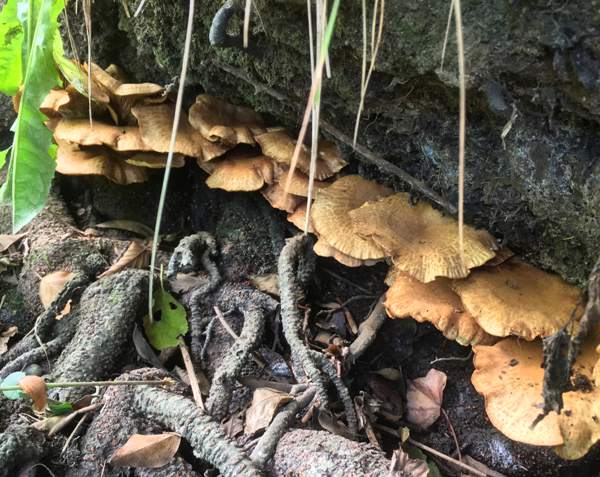
This gilled member of the order Boletales has been recently separated from other Alnus-specific Paxillus species. Like the boletes themselves it forms ectomycorrhizal relationships with trees - in this case Alders in wet habitats.
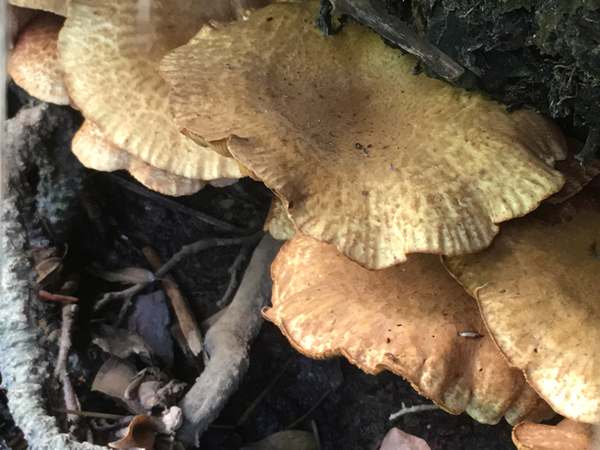
Distribution
Paxillus olivellus is an uncommon find but thought to be quite widely distributed in Britain and Ireland; it also occurs in several countries of mainland Europe including France; however, distribution information is limited because in the past this species is likely to have been misrecorded as Paxillus rubicundulus.
Taxonomic history
In 2016, French mycologist Pierre-Arthur Moreau (b. 1971) and colleagues carried out detailed molecular studies into the genus Paxillus which revealed two new Alder-specific mushrooms: Paxillus olivellus and Paxillus adelphus, the latter not yet recorded in Britain and Ireland. There appear to be no recorded synonyms of Paxillus olivellus.
Etymology
The generic name Paxillus means a 'peg' or a 'small stake', while the specific epithet olivellus comes from the Latin oliveus meaning olive coloured and refers to olive tinges on the surface of the cap of this mycorrhizal mushroom.
Toxicity
Other mushrooms in the Paxillus genus are known to be toxic, and in some circumstances deadly poisonous. It seems most likely that Paxillus olivellus is also a toxic toadstool.
Identification guide
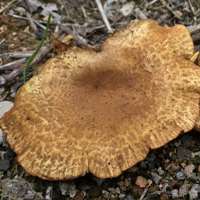 |
Cap
Initially broadly convex ten flattening, the olive-grey to buff cap is covered with irregular reddish-brown scales usually with a more continuous red-brown central patch. The velvety margin is lined and narrowly inrolled. Finely downy in dry weather, the
cap surface is viscid when wet.
Caps expand to between 2 and 12cm when fully mature. |
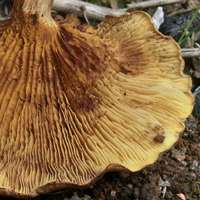 |
Gills
The decurrent. crowded gills are yellowish and bruise reddish brown.
Stem
0.7 to 1.5cm in diameter and 2 to 5cm long, the stem is more or less parallel sided and coloured as the cap or slightly lighter,
becoming rusty brown near the base when bruised. There is no stem ring. |
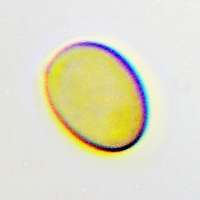 |
Spores
Broadly ellipsoidal, smooth, 6.4-7.9 x 4.3-5.1µm - significantly narrower than spores of Paxillus involutus.
Spore print
Olivaceous brown. |
Odour/taste |
Odour pleasant, some say fruity, but not distinctive; taste acidic. |
Habitat & Ecological role |
Mycorrhizal, under Alder trees (Alnus spp.),
particularly in damp or boggy soil. |
Season |
July to October in Britain and Ireland. |
Similar species |
The woodland Brown Rollrim Paxillus involutus (Batsch.: Fr.) Fr., has a much more involute margin, branching gills, and significanty longer spores.
Paxillus rubicundulus P. D. Orton is similar in macroscopic characters but has longer, more cylindrical spores, 6.6-8.5 x 4.4-5.2µm; it is also mycorrhizal with Alders (Alnus species). |
Reference Sources
Fascinated by Fungi, 2nd Edition, Pat O'Reilly 2016, reprinted by Coch-y-bonddu Books in 2022.
Paxillus rubicundulus (Boletales, Paxillaceae) and two new alder-specific ectomycorrhizal species, Paxillus olivellus and Paxillus adelphus, from Europe and North Africa. Jargeat P, Moreau PA, Gryta H, Chaumeton JP, and Gardes M. Fungal Biology, (2016)
Dictionary of the Fungi; Paul M. Kirk, Paul F. Cannon, David W. Minter and J. A. Stalpers; CABI, 2008
Taxonomic history and synonym information on these pages is drawn from many sources but in particular from the British Mycological Society's GB Checklist of Fungi.
Acknowledgements
This page includes pictures kindly contributed by Simon Harding.
Top of page...
Fascinated by Fungi. Back by popular demand, Pat O'Reilly's best-selling 450-page hardback book is available now. The latest second edition was republished with a sparkling new cover design in September 2022 by Coch-y-Bonddu Books. Full details and copies are available from the publisher's online bookshop...